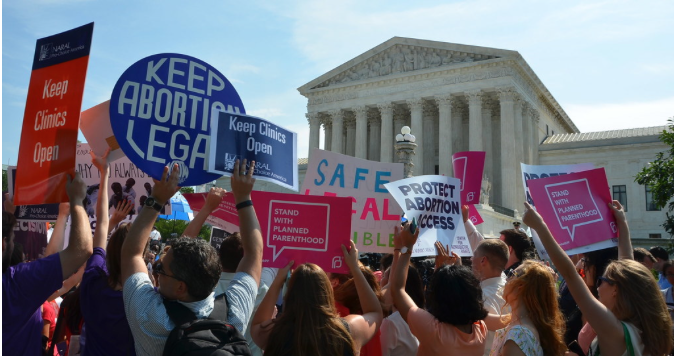Rachel Yuan
Current Events 📰
60 resourcesSee Units
What's Happening Right Now with the Texas Abortion Law?
If you’ve read, watched, or listened to the news in the past week, you likely have heard a lot of discussion surrounding the new Texas Abortion Law that came into effect on September 1st, 2021. This very restrictive abortion law has come into a lot of controversy, but to truly understand its impact and significance in America, we must explore the history of abortion laws in America.

Image From Wikimedia. Planned Parenthood escort stands outside of clinic.
History of Abortion Laws in America
America has a complicated history with abortion because of its significance in certain religions, which makes the issue even more partisan than others like taxes or healthcare. Until the sexual revolution during the 1960s and 1970s, abortion was not a politically contested issue. Conducting or obtaining an abortion was considered a felony prior to that time period, except for in very special cases. Then, in the 1970s, there was a move to illegalize abortions which was generally accepted by both parties. This was changed drastically in 1972, when the Republican presidential candidate Richard Nixon began taking a strong anti-abortion stance to gain more religious and socially conservative voters. While Nixon’s presidential campaign was not the sole cause for the political shift on abortion, it still signifies a prevalent polarization on this topic.
Political and Religious Difference on Abortion
Generally, Republicans, who tend to be more religious than Democrats, take the pro-life stance on abortion. Those who take the pro-life stance typically believe that abortions are immoral and should be illegal by law. Most branches of Christianity tend to view abortion as an act that goes directly against the Bible. As a result, most Republicans vote for politicians who take a pro-life stance against abortion. Most Democrats tend to take the pro-choice stance, which is that abortions should be legalized. Additionally, pro-choicers believe that the choice of abortion should be a woman’s choice. This of course is a generalization, as not all religious people are pro-life and not all non-religious people are pro-choice, but a majority of people who fall in either group tend to have similar opinions on the topic of abortion. This political divide is clearly extremely complex because the question of morality and religion is intermingled along with the several conflicting viewpoints on abortion.
Roe V. Wade
The issue of abortion became increasingly polarizing in the United States and on January 22, 1973, when the Supreme Court officially ruled that abortions could not be regulated in the first trimester of pregnancy. This ruling was extremely polarizing and it resulted in protests, outrage, and even calls to excommunicate Justice Brennan from the Catholic church.
Pro-life and Pro-choice Protests
The pro-life and pro-choice protests against abortion have only become increasingly common in the United States, as abortion continues to be a political issue that is at the forefront of political campaigns. Recently on the pro-life side, there have been protests in support of the new Texas abortion law. Additionally, pro-life protestors have newly been recognized as a permanent fixture of many abortion clinics. These protestors typically block patients from reaching the doors of these abortion clinics by handing them pamphlets and arguing with them. On the other hand, there have been several pro-choice protests in front of state capitols and even counter-protests to pro-life protestors who linger in front of abortion clinics.

Pro-choice protestors in front of Supreme Court.
About the Law
So, what does the new abortion law mean for women in Texas?
Well, the Texas abortion law bans abortions after 6 weeks of pregnancy. This means that women who get abortions after 6 weeks of pregnancy could be criminally charged or sued for breaking the law. Heatbeat laws such as this new Texas abortion law are not new, but this law has gained a lot of controversy because of how the law will be enforced. This new law essentially puts in place a bounty system for abortions as part of enforcement for the law. Ordinary citizens are encouraged to sue those who they found had an abortion after 6 weeks of a pregnancy. Those suing could be awarded up to $10,000 if successful in their lawsuits. Many pro-choice activists see this law as a way to incentivize publicly shaming women for having abortions and are extremely angry about it as a result.
Efforts to Stop the Law
While this law went into effect on September 1st, 2020, the law was actually signed by Texas Governor Greg Abbott in May 2021. Since this law was signed, there have been calls for the Supreme Court to block the abortion law because of Roe V. Wade. The Supreme Court declined to block the law the Wednesday right before the law went into effect on a vote of 5 to 4. This is not surprising as there have recently been 3 new Supreme Court Justices added by former President Trump who tend to take conservative/Republican stances when interpreting the law. This has led to a 6-3 Conservative majority within the Supreme Court.
There have been several protests from pro-choice groups in Texas who have come out against the new abortion law. Additionally, there have been many lawsuits brought out against pro-life organizations in Texas. There has also been an act proposed by the House called the “Women's Health Protection Act of 2021” which would essentially nullify the new Texas abortion law. This act passed easily in the House but will unlikely pass in the nearly evenly split Senate. There will likely be more lawsuits against the new abortion law and additional legislation that will challenge the Texas abortion law. So for now, the certainty of the legal right to abortion in the United States is very unclear.
Sources:
Connect with other students studying Current Events with Hours.
Browse Study Guides By Unit

Fiveable
Resources
© 2023 Fiveable Inc. All rights reserved.